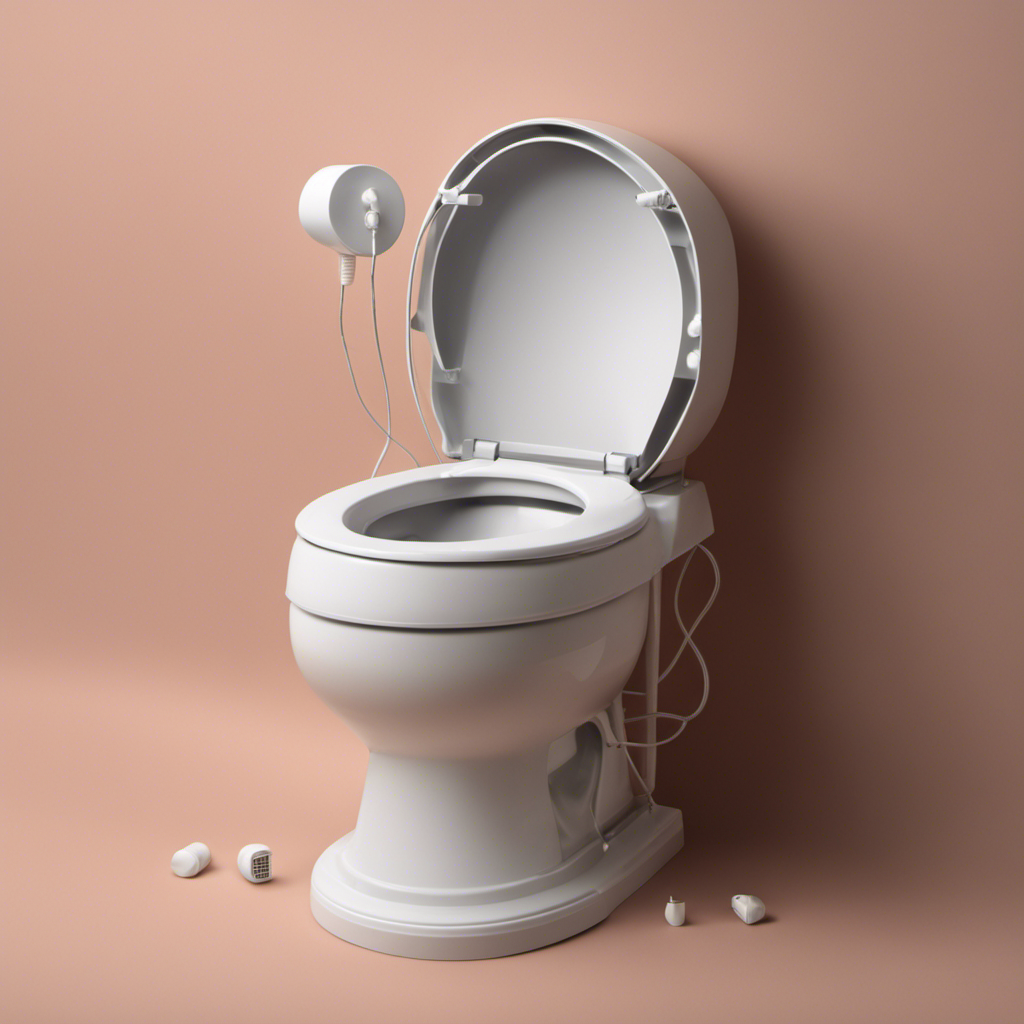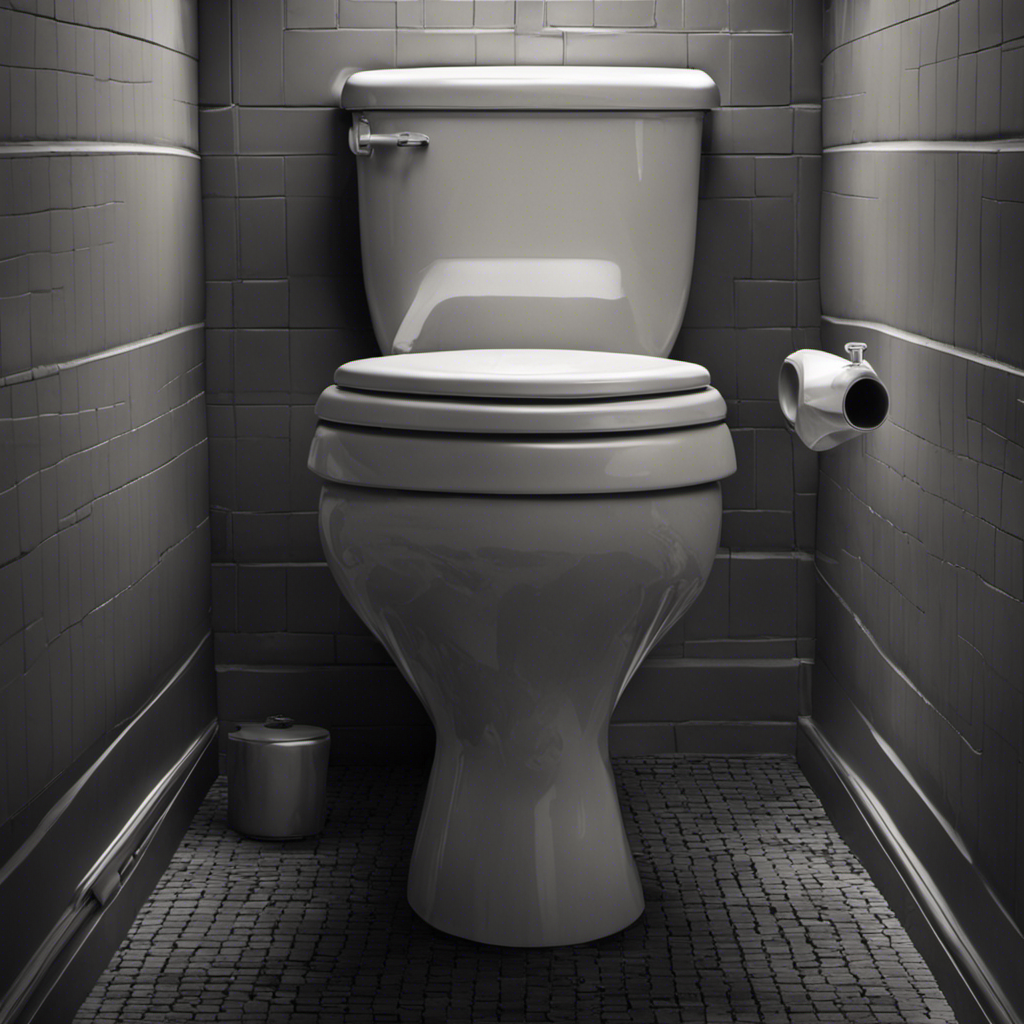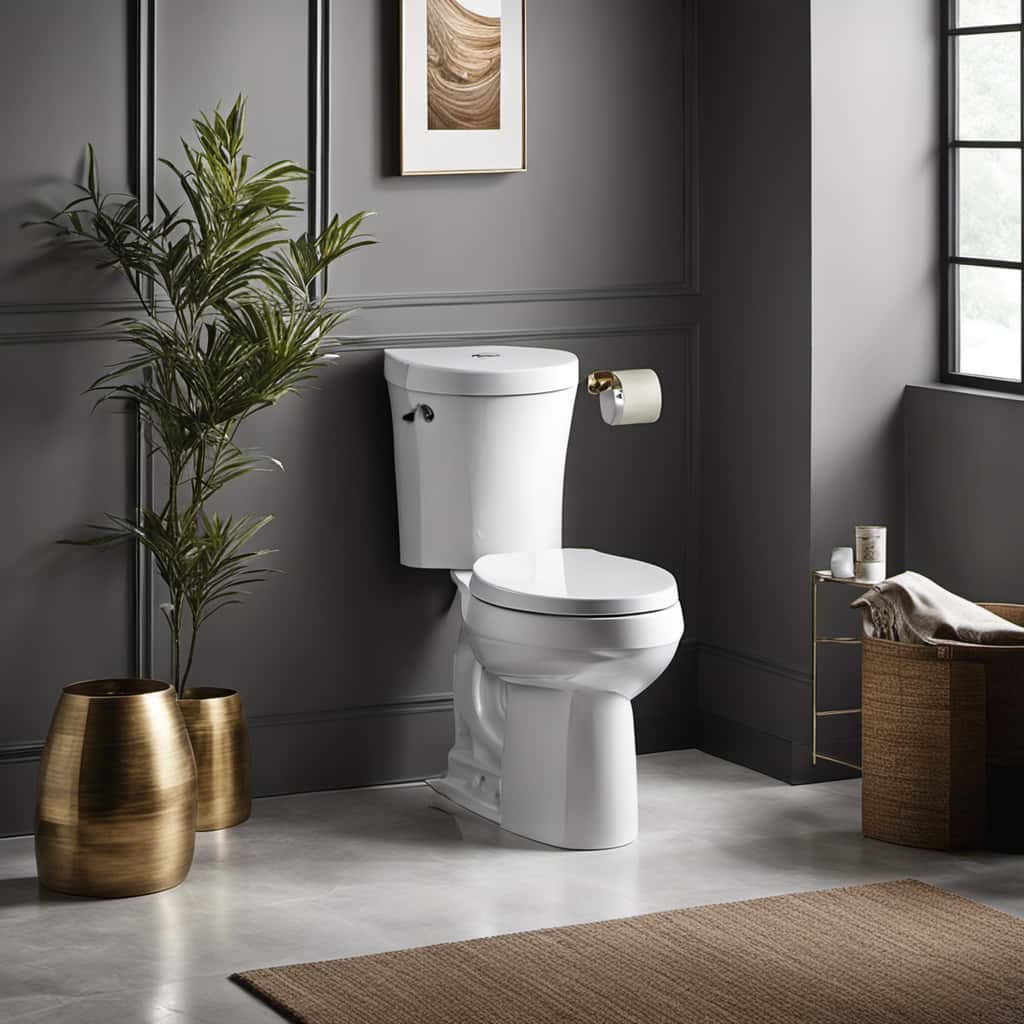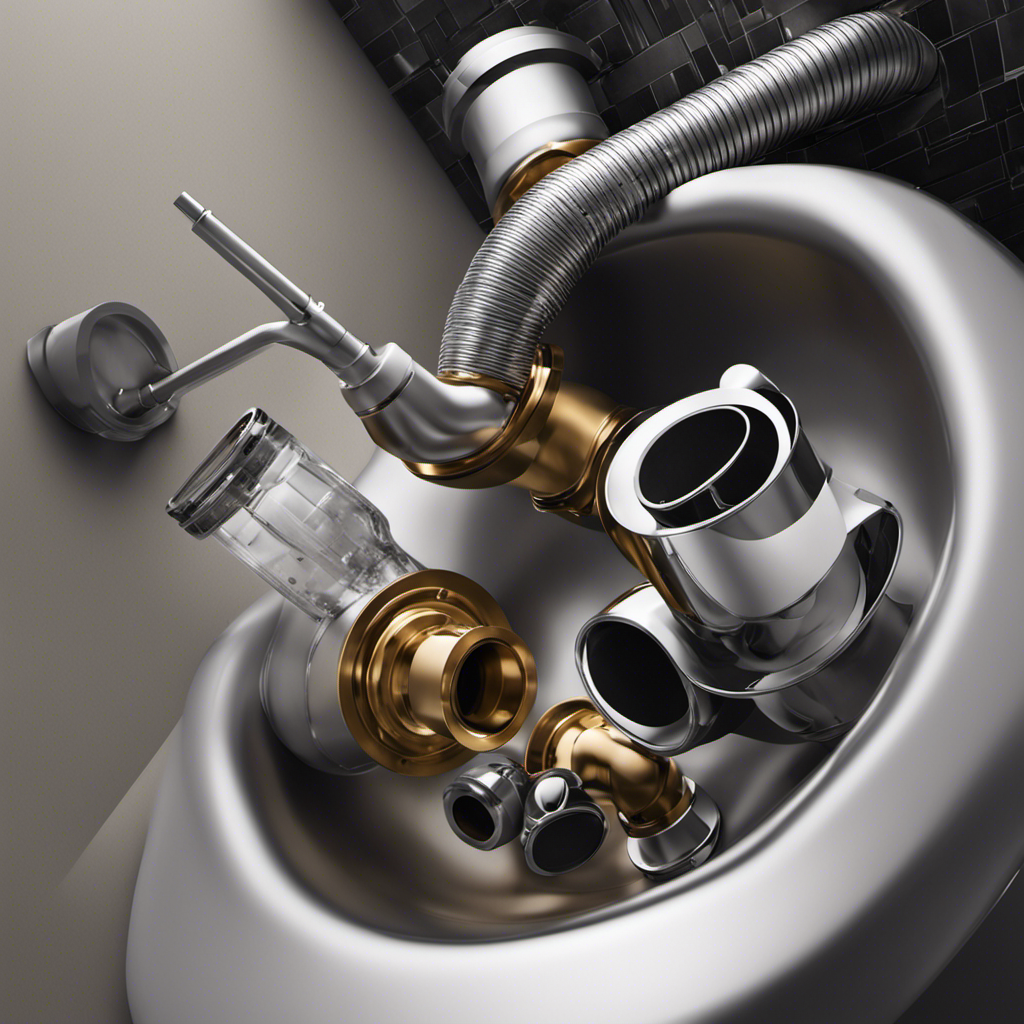As I listen to the high-pitched squeal emanating from my toilet, I can’t help but wonder, ‘Why does it make that noise?’
In this article, we will explore the common causes of toilet squealing and delve into the technical aspects behind it.
From understanding water pressure issues to dealing with faulty fill valves and malfunctioning flappers, we will leave no stone unturned in our quest for a silent and smoothly functioning toilet.
Let’s embark on this journey together and put an end to that irritating squeal once and for all.
Key Takeaways
- Faulty fill valves and malfunctioning flapper valves are common causes of toilet squealing.
- Loose pipes can contribute to vibrations and squealing in the toilet.
- Mineral buildup can affect water flow and potentially clog the toilet, leading to squealing.
- Regular maintenance and inspections can help prevent and address issues with loose pipes and noise in the plumbing system.
Common Causes of Toilet Squealing
One of the most common causes of a toilet squealing is a faulty fill valve. The fill valve is responsible for refilling the tank after each flush. When it becomes faulty, it may not close properly, causing water to continuously flow into the tank. This can lead to a high-pitched squealing noise.
Understanding noise factors in a toilet can help identify the issue and determine whether seeking professional help is necessary. Other noise factors to consider include a malfunctioning flapper valve, loose pipes, or a worn-out ballcock assembly.
If you’re unsure about the cause of the squealing or if it persists after attempting to fix it yourself, it’s advisable to seek professional help to prevent any further damage to your toilet system.
Understanding the Water Pressure Issue
To understand the water pressure issue, you should check if the water pressure in your home is too high. High water pressure can cause a range of problems, including leaks and damage to plumbing fixtures. It’s important to ensure that the water pressure in your home is within the recommended range to prevent any potential issues.
To help you understand the water pressure in your home, I’ve created a table that outlines the ideal water pressure range and the potential problems associated with high or low water pressure:
| Water Pressure | Ideal Range | Potential Problems |
|---|---|---|
| Too High | Above 80 psi | – Burst pipes |
- Leaking fixtures
- Damaged appliances |
| Ideal | 40-80 psi | – Optimal water flow - Minimal risk of leaks |
| Too Low | Below 40 psi | – Weak water flow - Difficulty in using multiple fixtures simultaneously |
The Role of Faulty Fill Valves
If you hear a high-pitched noise coming from your toilet, it’s likely that the fill valve is faulty. The fill valve plays a crucial role in regulating the water supply to the toilet tank. It controls the flow of water from the water supply line into the tank, allowing it to fill up after each flush.
A faulty fill valve can cause various issues, including the annoying squealing sound you might be hearing. One common cause of this problem is faulty seals within the fill valve. These seals can deteriorate over time, causing water to leak and creating a high-pitched noise.
To fix this issue, you will need to replace the faulty fill valve with a new one. It’s important to address this problem promptly to prevent any further damage to your toilet.
Dealing With a Malfunctioning Flapper
When a toilet’s flapper malfunctions, it can result in water constantly running into the bowl. Troubleshooting flapper issues is essential for maintaining the proper functioning of your toilet. Here are some steps to help you deal with a malfunctioning flapper:
-
Check for debris: Inspect the flapper for any debris or buildup that may be preventing it from sealing properly.
-
Adjust the chain length: Ensure that the chain connecting the flapper to the flush handle is properly adjusted. If it’s too tight or too loose, it can affect the flapper’s performance.
-
Replace worn out flappers: Over time, flappers can become worn out and lose their effectiveness. If troubleshooting doesn’t resolve the issue, consider replacing the flapper with a new one.
Exploring the Impact of Mineral Buildup
Mineral buildup can lead to decreased water flow and potential clogs in the toilet. It is important to prevent mineral buildup in order to maintain the proper functioning of your toilet.
There are a few ways to prevent mineral buildup in your toilet. First, you can use a water softener to reduce the mineral content in the water. This will help prevent the minerals from accumulating in the toilet.
Second, you can regularly clean the toilet bowl and tank to remove any mineral deposits that may have formed. This can be done using a mixture of vinegar and water or a commercial toilet cleaner.
Lastly, you can also install a water filtration system to remove minerals from the water before it enters the toilet.
Addressing the Problem of Loose Pipes
Let’s now shift our focus to the problem of loose pipes and how it can contribute to the annoying squealing sound in your plumbing system.
There are a few common causes for this issue, such as high water pressure, improper installation, or even the age of the pipes themselves.
To fix the problem, it is essential to identify the loose pipes and secure them properly, whether through tightening fittings or using specialized pipe clamps.
Additionally, taking preventive measures like regular maintenance and inspections can help avoid future issues with loose pipes and their associated squealing noises.
Causes of Squealing
To figure out what causes your toilet to squeal, you’ll want to check for any loose or worn parts in the fill valve or ballcock assembly. This is important because these components play a crucial role in regulating the water flow in your toilet.
Here are some possible causes of the squealing noise:
-
Water hammer: This occurs when the flow of water is suddenly stopped, causing a shockwave that can result in loud banging or squealing noises.
-
Plumbing noise: If there are loose pipes or fittings in your plumbing system, it can create vibrations and cause the toilet to squeal.
-
High water pressure: Excessive water pressure can put strain on the fill valve, leading to vibrations and noise.
Fixing Loose Pipes
If you notice loose pipes in your plumbing system, it’s important to address and fix them to prevent vibrations and further issues.
Loose pipes can lead to leaks and other damage, so it’s crucial to tighten the connections and secure them properly.
Start by turning off the water supply and draining any excess water from the pipes. Then, use a wrench or pliers to tighten the connections, making sure not to overtighten and cause damage.
Check all the connections, including those under sinks, behind toilets, and in the basement or crawl space.
If you find any damaged or worn-out pipes, replace them immediately to prevent leaks and potential water damage.
Regularly inspecting and maintaining your plumbing system will help prevent future issues and ensure its proper functioning.
Preventing Future Issues
Regularly inspecting and maintaining your plumbing system will help you avoid future issues and ensure it functions properly. Here are some maintenance tips to prevent leaks:
- Check for any signs of water damage or moisture around pipes and fixtures.
- Insulate exposed pipes to protect them from freezing temperatures.
- Keep drains clear by avoiding pouring grease, oil, or other substances down the drain.
Taking these preventive measures can help you avoid costly repairs and water damage caused by leaks.
However, if you do encounter any issues with your plumbing system, it’s important to troubleshoot other potential culprits.
Troubleshooting Other Potential Culprits
One possible culprit for the squealing noise in your toilet could be a faulty fill valve. The fill valve is responsible for regulating the flow of water into the toilet tank. If it is not functioning properly, it can lead to various issues, including the annoying squealing noise.
To troubleshoot this, start by turning off the water supply to the toilet. Next, flush the toilet to empty the tank completely. Then, carefully remove the fill valve and inspect it for any signs of damage or debris. Clean or replace the fill valve if necessary.
Conclusion
In conclusion, identifying and resolving the issue of a squealing toilet is crucial for a peaceful bathroom experience. By understanding the common causes such as water pressure problems, faulty fill valves, malfunctioning flappers, mineral buildup, and loose pipes, we can troubleshoot and fix the problem.
As the saying goes, ‘A stitch in time saves nine,’ it is essential to address the issue promptly to prevent further damage and costly repairs. Stay informed, be proactive, and enjoy a properly functioning toilet once again.










